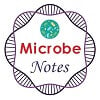
The main aim objective of this stain is to differentiate bacteria into acid fast group and non-acid fast groups.
Acid-fast mycobacteria contain mycolic acid in their outer membrane, making the cells waxy and resistant to staining with aqueous based stains such as the Gram stain. The primary stain, carbolfuchsin is applied to the cells, and heat and phenol are used to allow the stain to penetrate into the waxy surface of acid-fast microorganisms. The excess stain is removed with treatment by acid alcohol (ethanol and hydrochloric acid). A secondary stain, methylene blue, is then applied to the cells.
Primary Stain: 0.3% Carbol-fuchsin. Dissolve 50 g phenol in 100 mL ethanol (95%) or methanol (95%). Dissolve 3 g Basic fuchsin in the mixture and add distilled water to bring the volume to 1 L.
Decolorization Solution: Add 30 mL hydrochloric acid to 1 L of 95% denatured alcohol. Cool and mix well before use. Alternate decolorizing reagent (without alcohol): Slowly add 250 mL sulfuric acid (at least 95%) to 750 mL distilled water. Cool and mix well before using.
Counterstain: 0.3% nethylene blue. Dissolve 3 g nethylene blue in 1 L distilled water.
Acid fast: Bright red to intensive purple, Red, straight or slightly curved rods, occurring singly or in small groups, may appear beaded
Non-acid fast: Blue color; In addition, background material should stain blue.
Acid-fast: Mycobacterium tuberculosis, Mycobacterium smegmatis.
Non-Mycobacterial bacteria: Nocardia
Coccidian Parasites: Cryptosporidium
About Author